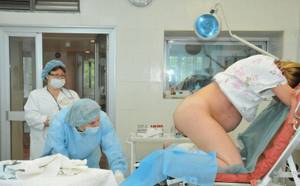The birth process itself is divided into several stages: from preparatory contractions to the release of the placenta. Most often, it is their preliminary stage that is delayed, when a pregnant woman at the 38th to 42nd week begins to feel very weak, inconsistent contractions and urgently comes to the maternity hospital, and there it turns out that her cervix is not yet ready for childbirth.
Childbirth is an absolutely natural process, but at the same time a serious test for both the mother and the child, who can no longer wait to be born. Since ancient times, it was believed that prolonged labor often leads to the birth of weak and sick children. All known medical practices since the time of Hippocrates formulated in different words one law for obstetrics and the course of this act: “The sun should rise over the head of a woman in labor only once,” that is, the duration of labor should not ultimately exceed 24 hours. And modern obstetricians-gynecologists have further reduced these limits, and in our time labor is considered normal for no more than 18 hours for women giving birth for the first time, and no more than 12 hours for already experienced mothers. But the level of knowledge about the physiology of labor is constantly increasing, and the fruits of this knowledge are a constant decrease in the time allotted for modern childbirth. Currently, the duration of the entire process already tends to be reduced to 8-10 hours, no more.
What's wrong with prolonged labor?
As you know, doctors do not like protracted labor and there is an explanation for this. The fact is that the course of labor extended over time greatly increases the likelihood of complications for both the mother and the fetus - this is the possibility of both injuries and infectious complications.
But this is not even the most important thing - during too long a labor, a pregnant woman becomes very tired, and the baby’s head, which is delayed and cannot appear outside, is subjected to pressure from all sides by the walls of the pelvis, and this is very dangerous and can lead to cerebral circulation disorders.
So why does it happen that contractions that started on time (between the 38th and 42nd weeks) and at first proceeded quite normally, later become less and less frequent, weaker, and sometimes even stop altogether? There can be a huge number of reasons for such weak labor activity:
- if you initially have endocrine and metabolic disorders in the body, for example, excess weight;
- if you are at too early or, conversely, late reproductive age;
- have thyroid disease;
- overstretching of the uterine muscles due to polyhydramnios;
- previous inflammatory diseases of the genital organs and abortions;
- a history of a large fetus or multiple pregnancy, as well as many other reasons.
Each of these reasons contributes to the destruction of the energy balance of contractile activity of the uterus and a decrease in the level of the hormone that stimulates uterine contractions - oxytocin.
Weakness of labor is not only secondary, which we have already talked about - if the contractions had satisfactory initial characteristics, and then weakened, but also primary - this is when they turn out to be rare and weak initially.
It happens when the water breaks, but contractions do not begin after that - this pathological condition has the same reasons, only the measures taken by doctors in this case will be called labor induction, and not labor stimulation.
Pregnancy and childbirth: numbers and records. What is a woman capable of?
Childbirth is mysterious in itself: suddenly something develops out of nothing in nine months! A person who is still groaning and straining, but in a month he will smile, in a year he will run and talk, in 7 years he will go to school, and in another 15 years he will give his mother grandchildren. What else is remarkable about childbirth?
27 births in the life of the wife of the Russian peasant Fyodor Vasiliev. In 40 years, from 1725 to 1765, she gave birth to 69 children. Twins were born 16 times, triplets were born 7 times, and 4 children were born 4 times.
The 2nd day of the week - Tuesday - is the most popular day for newborns: at this time the most of them are born. And the days of calm in labor are weekends, Saturday and Sunday.
In 1847 , pain relief was used for the first time during childbirth. The Scottish doctor James Young Simpson did this: he used chloroform. The child born (it was a girl) was named Anasthesia.
70 years old when she became the oldest mother in the world, having given birth to twins (dad was 77 at that time). To scrape together money for IVF, the couple mortgaged a plot of land, sold buffalos, spent their savings and took out a bank loan. The babies were born weighing a little more than a kilogram, but healthy. Before Omkari, the title of oldest mother was shared by 66-year-old Adriana Iliescu from Romania and Spaniard Carmela Bousada.
10.2 kg - this is how much the newborn son of Carmelina Fedele from Italian Aversa weighed. And the smallest newborn was a girl who was born prematurely in 1989 - she weighed only 281 g.
A 17-year-old African woman named Craig, living in the city of Vidhuke in Namibia, gave birth for 23 days The pregnancy was multiple, 6 twins were expected. Only 5 of them were born on October 15, and the 6th child was born 23 days later.
84 days . She was carrying twins, but one of them asked to be born before the other. So the girl Hana became the first, and her brother Eric was born only almost 3 months later.
2 minutes , it was recognized as the fastest. The waters broke, and after just one push, a healthy girl was born, who was named Vedika. And the Weiss family's first child, a boy, was born in just an hour.

Until the 17th century, all births were vertical. Louis XIV changed the tradition of the “Sun King”, and all out of curiosity: the king wanted to see how his heir was born, and the woman in labor was laid on her back.
Only 10% of babies are born on time, at 40 weeks of pregnancy. 38 weeks is the period at which the fetus is considered full-term, mature and ready to be born.
6-8 weeks are given to the female body to recover after childbirth. At this time, you need to maintain hygiene and limit physical activity. There is also a ban on sexual activity during this time. Sex after childbirth can be dangerous due to embolism - blockage of a blood vessel by air bubbles. British researchers report 18 cases of "deadly" postpartum sex in the UK between 1967 and 1993.
Help for a woman in labor
When does an expectant mother need help? The doctor makes a diagnosis of primary weakness if the contractions are short, rare and weak after 6 hours from the onset of labor in those giving birth for the first time, and after 3 hours in multiparous women (the cervix has not dilated by 2-3 cm) . We can talk about secondary weakness when contractions weaken and the cervix stops opening completely.
What is stimulation? Stimulation is necessary when the duration of either the first stage of labor (dilation of the cervix) or the second (appearance of the child) is excessively prolonged in time and then it is absolutely clear that this is a protracted labor. The doctor needs to pay attention to some points:
- Are there contractions, and what is their strength and frequency;
- Required uterine dilation (measured in cm, maximum dilation is 10 cm);
- How the presenting part of the fetus advances is determined by vaginal examination or by palpation of the abdomen.
If necessary, the doctor decides on stimulation.
On the eve of the fastest birth
Palak was pleasantly surprised by the lightning-fast birth of her second child. The woman expected the baby to appear faster, since she would become a mother for the second time. But it never even occurred to her how fast the upcoming birth would be. The father of the new girl was no less surprised. He was ready to support his wife during childbirth, but he only needed to call the doctors to the happy mother and her newly born child.

Palak still does not consider such a rapid birth to be a pure coincidence. During pregnancy, she was preparing for the birth of her baby. The woman paid a lot of attention to physical exercise. In her opinion, long daily walking contributed to such a quick birth of her daughter.
Recovery after natural childbirth
In a situation where natural childbirth took place without any complications, the woman’s recovery occurs quite quickly. After the baby is born, the woman in labor needs to spend several hours in the delivery room in a lying position, and after that she is allowed to get up, independently care for the baby and put herself in order. Pain in the perineum and unpleasant contractions of the uterus may bother you for some time, but usually this discomfort is minor. After 2–3 weeks, good health is restored. At the same time, the internal organs take longer to recover (complete healing of the wound surface at the placenta insertion site in the uterus requires 1.5–2 months).
In case of ruptures, episiotomy and other common complications, the recovery will be longer and more painful. The time frame remains the same - 6–8 weeks until the uterus heals, by which time the suture sites will also heal.
Caesarean or natural birth: which is better?
The ability to put a newborn baby to the breast immediately after birth is a huge advantage of natural childbirth over surgical birth. This significance lies not only in the physical contact of the closest people in the world, which has the most beneficial effect on the condition of both mother and child. The colostrum that the baby receives during the first feeding is of great value: this is the most valuable, most nutritious and richest first milk in the substances the baby needs!
Having a child is a lot of stress and hard work for him. It is very important for him to receive a reward for her in the form of a mother’s tender hugs and colostrum, the smell of which is familiar to the child from the womb! In this case, babies adapt more easily to new living conditions and recover faster after birth. But natural childbirth has other undeniable advantages over cesarean section.
Natural childbirth takes place in several stages, each of which is a preparation for the next. This helps to experience childbirth as comfortably and safely as possible for all participants - both mother and baby. If the birth takes place by opening the abdominal cavity, the child abruptly moves from one environment to another and does not have time to go through all these stages, as with a natural birth.
Caesarean section is a great stress for the maternal and child’s body; it is an artificial and often unwanted intervention in the processes inherent in nature itself. And therefore it does not pass without a trace. However, in some cases, such an operation, unfortunately, cannot be avoided. If, for medical reasons, doctors insist on giving birth by cesarean section, then you should listen to the opinion of doctors.
Poses for natural childbirth
Women in labor are usually allowed to spend the painful period of labor in the way they feel most comfortable. You can walk around the room, lean on the bed or wall, sit on a ball, lie down, or even stand under a warm shower. It is recommended to make rocking movements with the pelvis - this helps the uterus to open. During pushing, when the baby is already born, the most common position is lying on the back with bent legs resting on special handles on the birthing bed. This position of a woman in labor is undoubtedly the most convenient for doctors, but studies in recent years have shown that a lying position for an expectant mother is extremely uncomfortable: the baby’s head presses on the spine, causing additional pain, and puts serious pressure on the veins located in the pelvis. But in some cases, the classic lying position is extremely useful: when administering epidural anesthesia to evenly distribute the drug, during rapid labor and breech presentation of the fetus.

The classic position for childbirth - lying on your back with the top raised - is as comfortable as possible for doctors and in situations with rapid and premature labor is the only possible
At the request of the woman in labor and with the consent of the doctor, other positions during childbirth are possible:
- standing on all fours;
- squatting;
- standing with support on hands;
- lying on your side, etc.
Today, vertical childbirth has become very popular. During the process there is no such strong pressure on the vessels and nerves in the back, the fetus moves easier and faster, but this also has a number of disadvantages. So, if the classic horizontal position is common and every modern maternity hospital has a special bed for occupying the most productive position during pushing, then chairs for vertical childbirth are rare. Also, the vertical position is contraindicated during rapid labor, as this will further speed up the process, and in the presence of any diagnosed risks for the mother or fetus.

Vertical birth is possible only in the absence of complications and at a normal speed of the process, since rapid delivery will only speed up










